Attached files
| file | filename |
|---|---|
| 8-K - 8-K - DYCOM INDUSTRIES INC | dy-20200916.htm |
| EX-99.2 - EX-99.2 - DYCOM INDUSTRIES INC | dyfy2021q2non-gaapreco.htm |
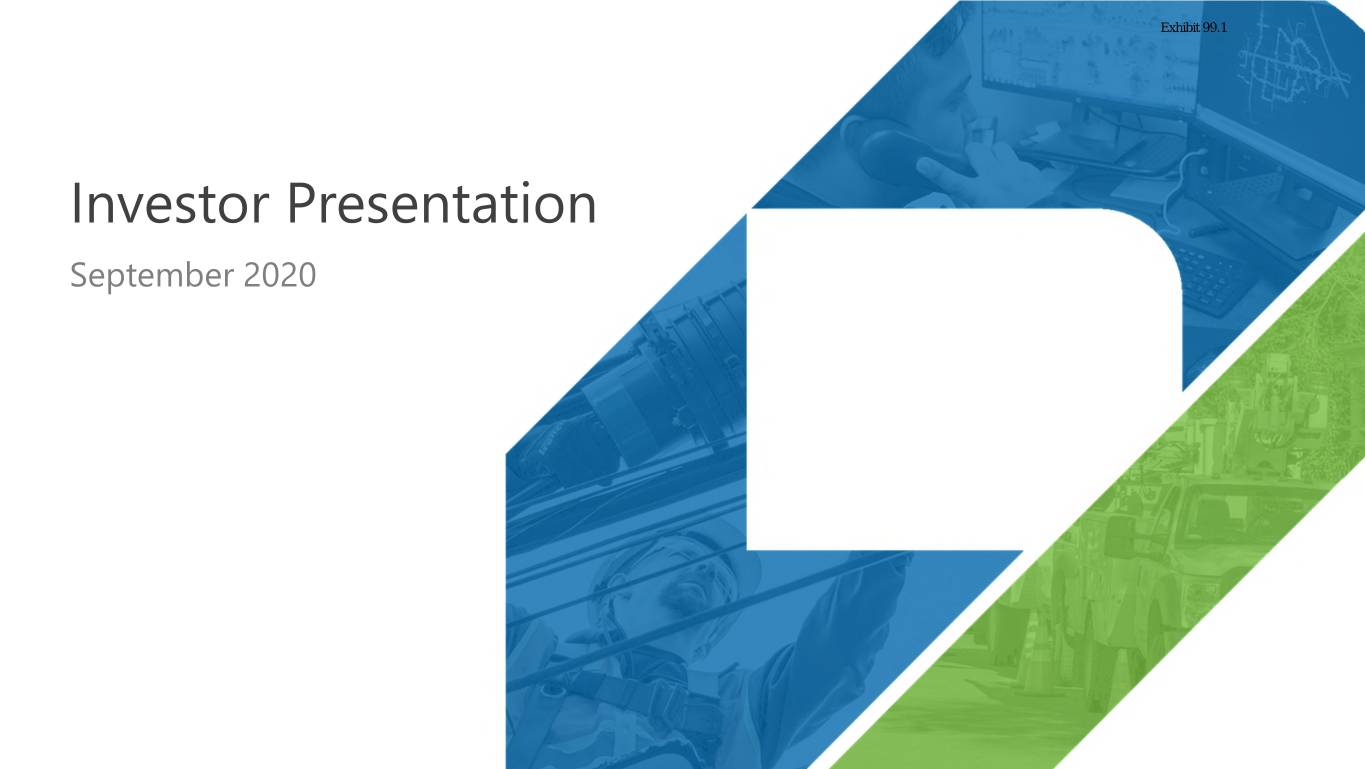
Exhibit 99.1 Investor Presentation September 2020

Important Information Caution Concerning Forward-Looking Statements This presentation contains forward-looking statements as contemplated by the 1995 Private Securities Litigation Reform Act. These statements include those related to the outlook for the quarter ending October 24, 2020 found within this presentation. These statements are subject to change. Forward looking statements are based on management’s current expectations, estimates and projections. These statements are subject to risks and uncertainties that may cause actual results for completed periods and periods in the future to differ materially from the results projected or implied in any forward-looking statements contained in this presentation. The most significant of these risks and uncertainties are described in the Company’s Form 10-K, Form 10-Q, and Form 8-K reports (including all amendments to those reports) and include the projected impact of COVID-19 on the Company’s business operating results, cash flows and/or financial condition and the impacts of the measures the Company has taken in response to COVID-19, the Company’s ability to effectively execute its business and capital plans, business and economic conditions and trends in the telecommunications industry affecting the Company’s customers, customer capital budgets and spending priorities, the adequacy of the Company’s insurance and other reserves and allowances for doubtful accounts, whether the carrying value of the Company’s assets may be impaired, preliminary purchase price allocations of acquired businesses, expected benefits and synergies of acquisitions, the future impact of any acquisitions or dispositions, adjustments and cancellations of the Company’s projects, the related impact to the Company’s backlog from project cancellations, weather conditions, the anticipated outcome of other contingent events, including litigation, liquidity and other financial needs, the availability of financing, the Company’s ability to generate sufficient cash to service its indebtedness, restrictions imposed by the Company’s credit agreement, and the other risks and uncertainties detailed from time to time in the Company’s filings with the Securities and Exchange Commission. The Company does not undertake any obligation to update forward-looking statements. Non-GAAP Financial Measures This presentation includes certain “Non-GAAP” financial measures as defined by Regulation G of the SEC. As required by the SEC, an explanation of the Non-GAAP financial measures and a reconciliation of those measures to the most directly comparable GAAP financial measures are provided in the Company’s Form 8-K filed with the SEC on September 16, 2020 and on the Company’s Investor Center website at https://ir.dycomind.com. Non-GAAP financial measures should be considered in addition to, but not as a substitute for, the Company’s reported GAAP results. 2

Dycom Overview Leading supplier of specialty contracting services to telecommunication providers Operates throughout the continental United States Nationwide footprint with 44 operating subsidiaries and over 14,000 employees Strong revenue base and customer relationships Contract revenues of $823.9 million for Q2 2021, compared to $884.2 million for Q2 2020 Non-GAAP Adjusted EBITDA for Q2 2021 of $102.7 million, or 12.5% of contract revenues, compared to $89.2 million, or 10.2% of contract revenues, for Q2 20201 Non-GAAP Adjusted Diluted Earnings per Common Share of $1.18 for Q2 2021, compared to $0.86 for Q2 20201 Solid financial profile Strong liquidity of $474.0 million at Q2 2021 Reduced notional net debt by $94.0 million during Q2 2021 and by $357.3 million since Q3 2020 Authorized $100 million for share repurchases through February 2022 3
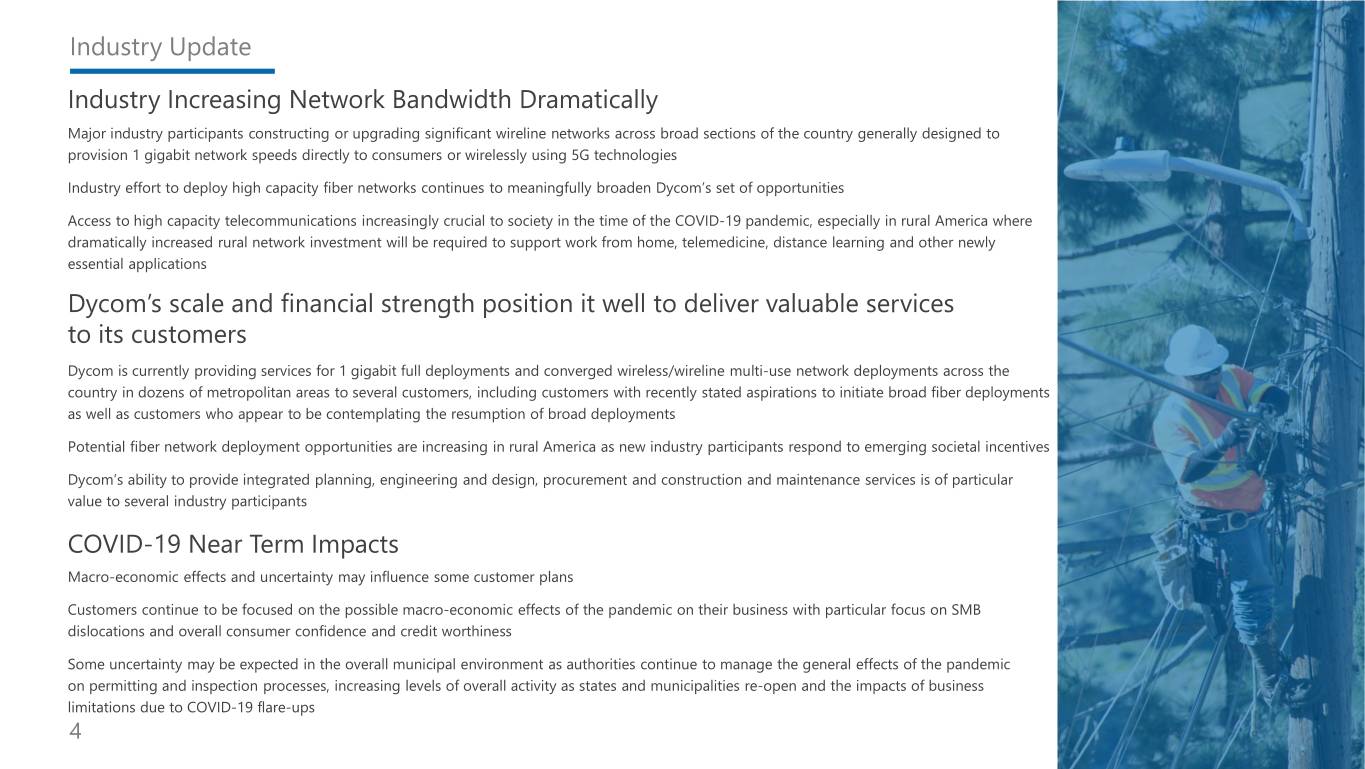
Industry Update Industry Increasing Network Bandwidth Dramatically Major industry participants constructing or upgrading significant wireline networks across broad sections of the country generally designed to provision 1 gigabit network speeds directly to consumers or wirelessly using 5G technologies Industry effort to deploy high capacity fiber networks continues to meaningfully broaden Dycom’s set of opportunities Access to high capacity telecommunications increasingly crucial to society in the time of the COVID-19 pandemic, especially in rural America where dramatically increased rural network investment will be required to support work from home, telemedicine, distance learning and other newly essential applications Dycom’s scale and financial strength position it well to deliver valuable services to its customers Dycom is currently providing services for 1 gigabit full deployments and converged wireless/wireline multi-use network deployments across the country in dozens of metropolitan areas to several customers, including customers with recently stated aspirations to initiate broad fiber deployments as well as customers who appear to be contemplating the resumption of broad deployments Potential fiber network deployment opportunities are increasing in rural America as new industry participants respond to emerging societal incentives Dycom’s ability to provide integrated planning, engineering and design, procurement and construction and maintenance services is of particular value to several industry participants COVID-19 Near Term Impacts Macro-economic effects and uncertainty may influence some customer plans Customers continue to be focused on the possible macro-economic effects of the pandemic on their business with particular focus on SMB dislocations and overall consumer confidence and credit worthiness Some uncertainty may be expected in the overall municipal environment as authorities continue to manage the general effects of the pandemic on permitting and inspection processes, increasing levels of overall activity as states and municipalities re-open and the impacts of business limitations due to COVID-19 flare-ups 4

Industry Drivers Solid end market activity despite challenging economic backdrop Fiber deployments enabling new wireless technologies are underway in many regions of the country Telephone companies are deploying FTTH to enable 1 gigabit high speed connections Fiber deep deployments to expand capacity as well as new build opportunities are underway Dramatically increased speeds to consumers are being provisioned and consumer data usage is growing, particularly upstream Customers are consolidating supply chains creating opportunities for market share growth and increasing the long- term value of Dycom’s maintenance and operations business Dycom is increasingly providing integrated planning, engineering and design, procurement and construction and maintenance services for wired and converged wireless/wireline networks Remain encouraged that Dycom’s major customers continue to be committed to multi-year capital spending initiatives 5

Strong Secular Trend North America Internet Protocol Traffic vs. GDP Growth Data Usage Growth & Broadband Speeds 20% 80,000 Weighted Average Data Consumed Provisioned Speed Tiers of Broadband s per Month Subscribers e t 15% 60,000 y 400 100% b 380 a g i 10% 40,000 G 90% 350 5% 20,000 80% c 300 ) i e f h 280 f g 0% - t a n 70% n r 58% a o T h P M C I 250 r P (5)% (20,000) a e 60% c D i p r G s e e y l t m r (10)% (40,000) y 200 50% e A b t r a h t t a r e u (15)% (60,000) o P Q ( 40% N 150 (20)% (80,000) 30% 100 (25)% (100,000) 20% 42% (30)% (120,000) 50 10% (35)% (140,000) - 2000 2002 2004 2006 2008 2010 2012 2014 2016 2018 0% 2Q-19 2Q-20 <100 Mbps 100+ Mbps Sources: U.S. Telecom, The Broadband Association; Cisco Visual Networking Index; U.S. National Bureau of Economic Analysis Source: OpenVault Broadband Industry Report 2Q 2020 Strong and stable growth in IP traffic even in times of GDP The average subscriber now consumes 380+ GB per month, decline an increase of 36% from Q2 2019 Telecommunications networks fundamental to economic Over half of these subscribers are provisioned at speeds of progress 100+ Mbps IP traffic in North America will reach 108.4 EB per month by 2022, Increasing consumer demand for bandwidth continues to “ growing at a CAGR of 21 percent. drive fiber deployments by telecom providers - Cisco Visual Networking Index: Forecast and Trends, 6 2017–2022 White” Paper - February 2019

Key Driver: High Bandwidth Deployments Companies deploying fiber-to-the-home, fiber-to-the-node, and fiber-to-the-building technologies to enable 1 gigabit connections Data transmission speeds dramatically increasing Verizon AT&T d 80 e 5,000 t c ) s e 70 4,500 0 n 0 n 0 ( o 4,000 C s 60 r s e t 3,500 b i e 5G Home r k c r 50 s 3,000 a b 5G Mobile u M S 2,500 40 d n a 2,000 b 30 60 d a 1,500 o r B 1,000 20 r e b 31 i 500 F 10 0 10 0 5 Q3-18 Q4-18 Q1-19 Q2-19 Q3-19 Q4-19 Q1-20 Q2-20 2019 2020 We talked about getting another 30 cities on 5G Mobility this year. We're very much So on the broadband side, look, I have an appetite to get back to building on track with that. We talked about getting 10 MEC locations up and running, the footprint on fiber. And I think I've indicated that before. And I wouldn't quite “ mobile edge compute on 5G. We announced two of those last week, the big “ pigeon hole it in the way you asked the question relative to households. I announcement with AWS. And then also getting the 5G home markets up and have an appetite to build fiber that serves a combination of our needs in the running this year, we're on track with that. We're getting the next-generation chipset consumer space, what we need to do to deploy 5G, and what can help our right now into the CPE devices. Look forward to launching that here later in the Business segment. second half of the year and really rolling that out. So we're on track with all of the - John Stankey, CEO priorities we laid out at the start of the year. - Matt Ellis, EVP & CFO AT&T, Inc. – July 2020 Verizon” Communications, Inc. – August 2020 ” 7
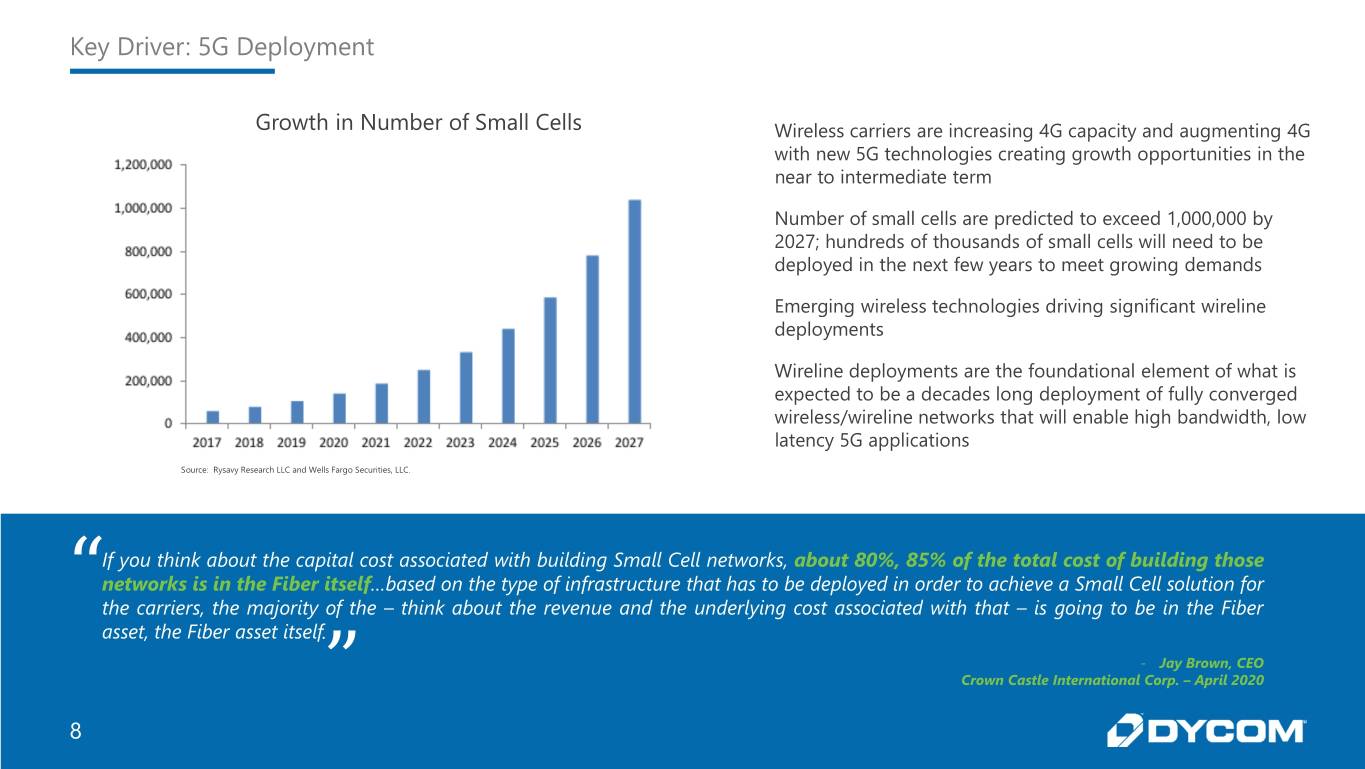
Key Driver: 5G Deployment Growth in Number of Small Cells Wireless carriers are increasing 4G capacity and augmenting 4G with new 5G technologies creating growth opportunities in the near to intermediate term Number of small cells are predicted to exceed 1,000,000 by 2027; hundreds of thousands of small cells will need to be deployed in the next few years to meet growing demands Emerging wireless technologies driving significant wireline deployments Wireline deployments are the foundational element of what is expected to be a decades long deployment of fully converged wireless/wireline networks that will enable high bandwidth, low latency 5G applications Source: Rysavy Research LLC and Wells Fargo Securities, LLC. If you think about the capital cost associated with building Small Cell networks, about 80%, 85% of the total cost of building those “ networks is in the Fiber itself…based on the type of infrastructure that has to be deployed in order to achieve a Small Cell solution for the carriers, the majority of the – think about the revenue and the underlying cost associated with that – is going to be in the Fiber asset, the Fiber asset itself. - Jay Brown, CEO ” Crown Castle International Corp. – April 2020 8

Intensely Focused on Telecommunications Market Complete Lifecycle Services Crucial to Customers’ Success INSTALLATION MAINTENANCE Wireline Wireless PROCUREMENT PROGRAM CONSTRUCTION MANAGEMENT ENGINEERING & DESIGN Q2 2021 Revenue by Customer Type: 90.6% 7.2% 2.2% Telecommunications Underground Electric/Gas Locating Utilities & Other Dycom is well-positioned to benefit from future growth opportunities 9

Local Credibility, National Capability Operating Subsidiaries

Well Established Customers Top 5 Customers Q2 2021 Organic growth (decline)2: (6.8)% (9.2)% 2.0% Top 5 customers represented 76.6% and 78.6% of contract Total Customers Top 5 Customers All Other Customers revenues in Q2 2021 and Q2 2020, respectively Q2 2021 % of contract revenues from customers #6 through #10: 14.2% 25.2% 2.4% 1.8% 1.5% 1.0% 1.0% CenturyLink Windstream Charter Dominion Energy Frontier Customer #9 NiSource 11

Durable Customer Relationships $ Millions s e $900 u n e v e $800 R t c a $700 r t n o Verizon C $600 r e m AT&T o $500 t s u C $400 CenturyLink $300 Comcast $200 Windstream $100 Charter $- 2016 2017 2018 2019 2020 Trailing Twelve Months Ended January8 s e u $4,000 n e v $3,340 e $3,500 R $3,128 t $2,978 c $2,954 a r $3,000 t n o C $2,500 $2,290 r e m o t $2,000 78% s 74% 77% 78% u Top 5 Customers C $1,500 66% All Other Customers $1,000 $500 34% 26% 23% 22% 22% $- 2016 2017 2018 2019 2020 Trailing Twelve Months Ended January8 12

Anchored by Long-Term Agreements Revenue by Contract Type for Fiscal 2020 Backlog3 Master Service Agreements 65.4% 23.2% 11.4% Short-term contracts Long-term contracts Dycom is party to hundreds of MSA’s and other agreements with customers that extend for periods of one or more years Generally multiple agreements maintained with each customer Master Service Agreements (MSA’s) are multi-year, multi-million dollar arrangements covering thousands of individual work orders generally with exclusive requirements; majority of contracts are based on units of delivery Backlog at $6.441 billion as of Q2 2021 13

10+ Years of Robust Cash Flow Generation $2,117 $2,117 Strong operating cash flow of Business Other Cash Flow Acquisitions $709 $618 $1.357 billion over 10+ years Prudent approach to capital allocation: Share Repurchases $444 $444 million invested in share repurchases $618 million invested in business acquisitions Cash Flow from Operations $1,055 million in cap-ex, net of disposals, or $1,357 Cap-Ex, net approximately 50% of allocation $1,055 Net Decrease in Cash , $50 Fiscal 2010 – Fiscal 2020 Robust cash flow generation and prudent capital allocation provide strong foundation for returns 14

Financial Update
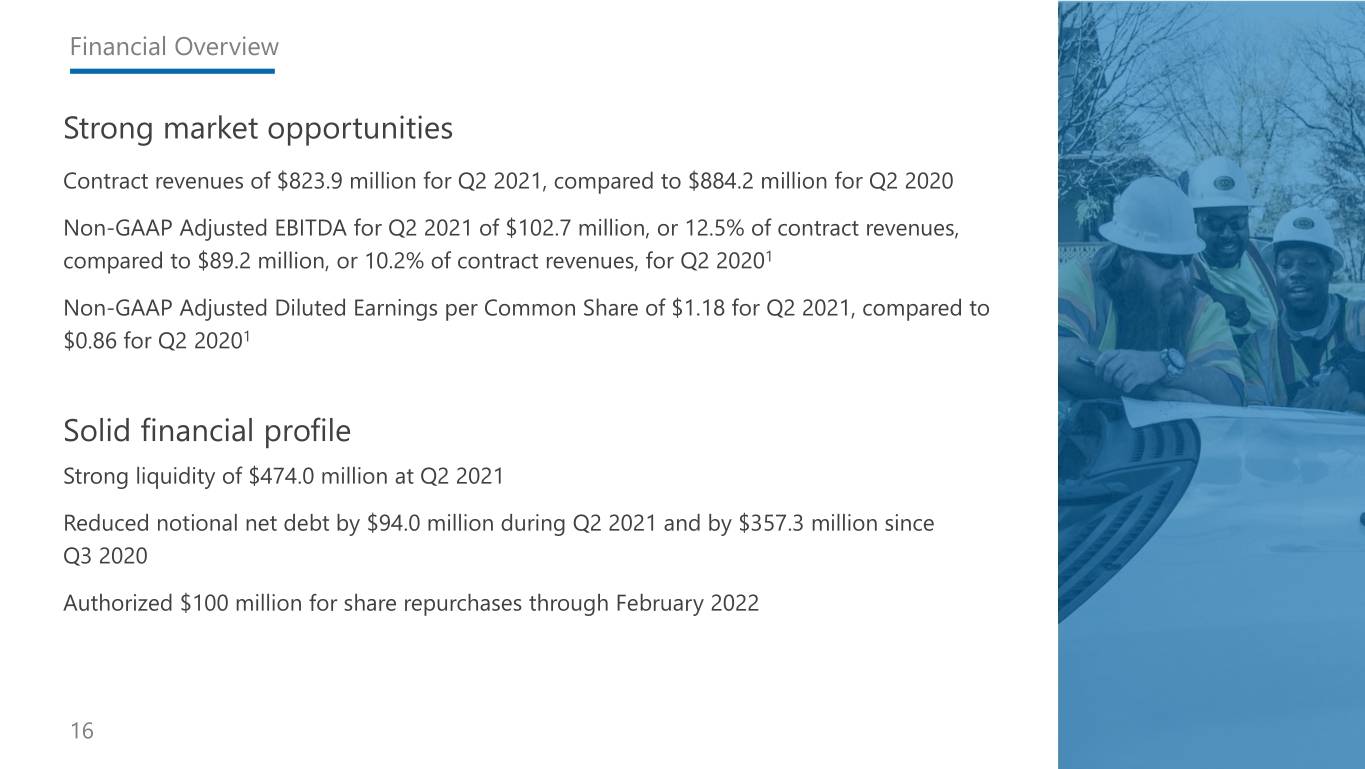
Financial Overview Strong market opportunities Contract revenues of $823.9 million for Q2 2021, compared to $884.2 million for Q2 2020 Non-GAAP Adjusted EBITDA for Q2 2021 of $102.7 million, or 12.5% of contract revenues, compared to $89.2 million, or 10.2% of contract revenues, for Q2 20201 Non-GAAP Adjusted Diluted Earnings per Common Share of $1.18 for Q2 2021, compared to $0.86 for Q2 20201 Solid financial profile Strong liquidity of $474.0 million at Q2 2021 Reduced notional net debt by $94.0 million during Q2 2021 and by $357.3 million since Q3 2020 Authorized $100 million for share repurchases through February 2022 16

Annual Trends Growth in Contract Revenues Non-GAAP Adjusted EBITDA $3,340 $442 s $3,067 $3,128 s n $2,978 n $390 o $384 o i i l l l $2,673 l i i $330 M M $310 $ $ 14.6% 14.4% 12.9% 10.5% 9.3% FY2016 FY2017 4 Quarters Ended FY2019 FY2020 FY2016 FY2017 4 Quarters Ended FY2019 FY2020 8 8 Jan. 2018 Jan. 2018 Non-GAAP Adjusted EBITDA Non-GAAP Adjusted EBITDA as a % of Revenue Organic Revenue Trend2 Non-GAAP Adjusted Diluted EPS 22.7% $5.26 $4.48 14.1% $3.88 8.3% 3.6% $2.78 (0.2)% $2.27 FY2016 FY2017 4 Quarters Ended FY2019 FY2020 8 Jan. 2018 FY2016 FY2017 4 Quarters Ended FY2019 FY2020 Jan. 2018 8 17
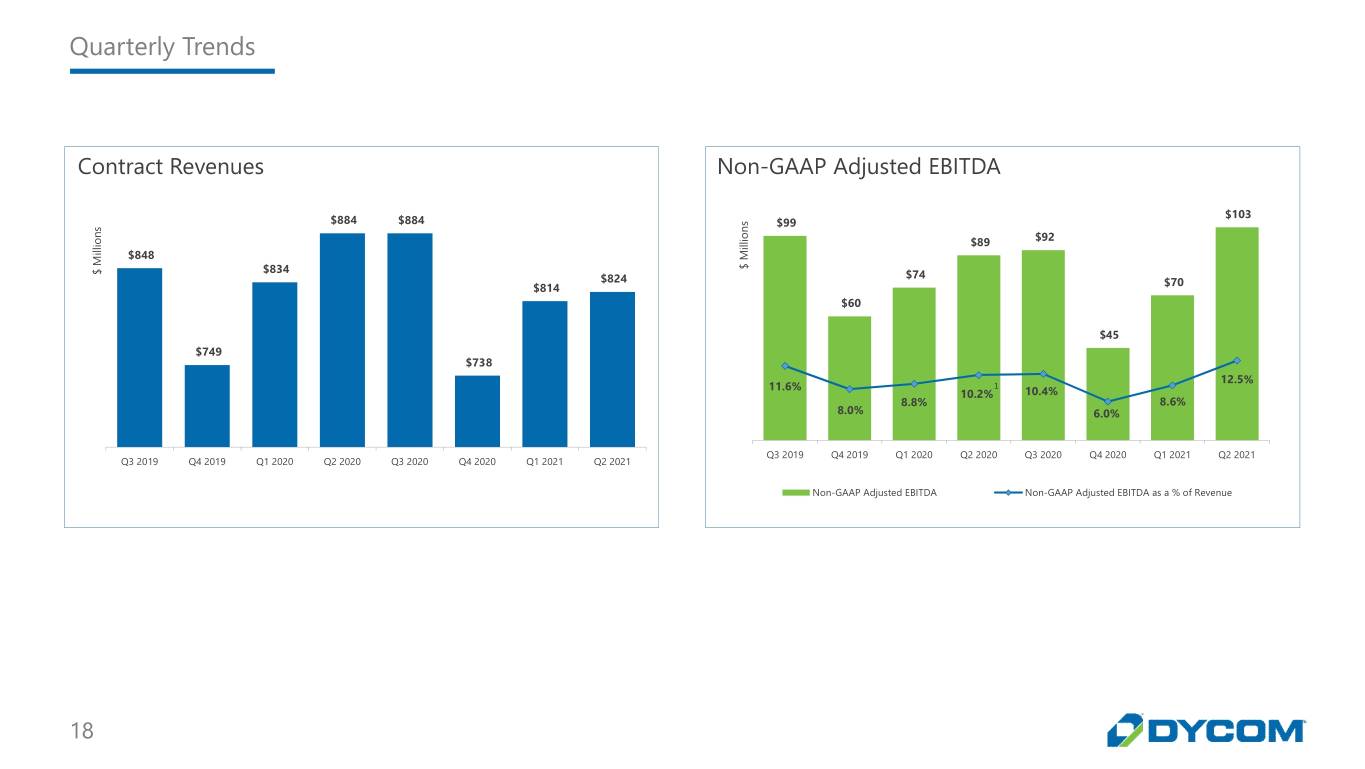
Quarterly Trends Contract Revenues Non-GAAP Adjusted EBITDA $103 $884 $884 s $99 s n n o i $92 o l i l $89 l i l i $848 M M $ $ $834 $74 $824 $70 $814 $60 $45 $749 $738 12.5% 11.6% 1 10.2% 10.4% 8.8% 8.6% 8.0% 6.0% Q3 2019 Q4 2019 Q1 2020 Q2 2020 Q3 2020 Q4 2020 Q1 2021 Q2 2021 Q3 2019 Q4 2019 Q1 2020 Q2 2020 Q3 2020 Q4 2020 Q1 2021 Q2 2021 Non-GAAP Adjusted EBITDA Non-GAAP Adjusted EBITDA as a % of Revenue 18

Liquidity Overview $ Millions Q1 2021 Q2 2021 Debt Summary 0.75% Convertible Senior Notes, mature Sept 2021: $ 293.0 $ 58.3 Senior Credit Facility, matures Oct 2023:4 Term Loan Facilities 438.8 433.1 Revolving Facility 675.0 200.0 Total Notional Amount of Debt $ 1,406.7 $ 691.4 Less: Cash and Equivalents 643.9 22.5 Notional Net Debt7 $ 762.9 $ 668.9 $(357.3) $ Millions Q2 2020 Q2 2021 Cash Flow Summary Cash (used in) provided by operating activities $ (53.6) $ 82.3 Capital expenditures, net of disposals $ (32.8) $ (2.5) (Repayments) Borrowings on Senior Credit Facility $ 65.0 $ (480.6) Purchase of 0.75% Convertible Senior Notes, net of discount $ - $ (223.9) Other financing & investing activities, net $ 0.4 $ 3.4 7 7 Total Days Sales Outstanding ("DSO")6 117 126 Reduced notional net debt by $357.3 million since Q3 2020, including a Robust operating cash flows of $82.3 million during Q2 2021 and $167.5 million Q2 2021 reduction of $94.0 million; during Q2 2021: year-to-date from prudent working capital management . Generated solid free cash flow DSOs of 126 at Q2 2021 sequentially in line with DSO’s of 125 at Q1 2021 . Purchased $234.7 million principal amount of Notes for $224.4 million, including interest and fees Capital expenditures, net of disposals for fiscal 2021 anticipated at $60 - $70 million, . Repaid $475.0 million on Revolver in-line with prior outlook . Repaid $5.6 million of Term Loan borrowings Strong liquidity5 of $474.0 million as of July 25, 2020 19

Capital Allocated to Maximize Returns Dycom is committed to maximizing long term returns through prudent capital allocation Invest in Organic Growth Focus on organic growth opportunities through strategic capital investments in the business Reduce Leverage to Historical Levels Generate free cash flow to reduce net debt Pursue Complementary Acquisitions Selectively acquire businesses that complement our existing footprint and enhance our customer relationships Acquisitions have further strengthened Dycom’s customer base, geographic scope, and technical service offerings Shares Repurchases Repurchased 23.9 million shares for approximately $658 million since fiscal 2006 $100.0 million authorization available for share repurchases through February 2022 20

Questions and Answers 21

Outlook This slide was used on August 26, 2020 in connection with the Company’s conference call for its fiscal 2021 second quarter results. This information is provided for your reference only and should not be interpreted as a reiteration of these projections by the Company at any time after the date originally provided. Reference is made to slide 2 titled “Important Information” with respect to these slides. The information and statements contained in this slide that are forward-looking are based on information that was available at the time the slide was initially prepared and/or management’s good faith belief at that time with respect to future events. Except as required by law, the Company may not update forward-looking statements even though its situation may change in the future. For a full copy of the conference call materials, including the conference call transcript, see the Company’s Form 8-Ks filed with the Securities and Exchange Commission on August 26, 2020. The Company continues to closely monitor the impact of the COVID-19 pandemic on all aspects of its business Based on current conditions, the Company anticipates contract revenues and margins to range from in-line to modestly lower on a sequential basis for Q3 2021 as compared to Q2 2021 The Company believes the impact of the COVID-19 pandemic on its operating results, cash flows and financial condition is uncertain, unpredictable and may be outside of its control 22

Notes 1) During the quarter ended July 27, 2019, the Company entered into a contract modification that increased revenue produced by a large customer program. As a result, the Company recognized $11.8 million of contract revenues for services performed in prior periods, $0.8 million of related performance-based compensation expense, and $1.0 million of stock-based compensation. On an after-tax basis, these items contributed approximately $7.2 million to net income, or $0.23 per common share diluted, for the quarter and six months ended July 27, 2019. These amounts are excluded from the calculation of Non-GAAP Adjusted EBITDA, Non-GAAP Adjusted Net Income and Non-GAAP Adjusted Diluted Earnings per Common Share for the quarter and six months ended July 27, 2019. 2) Organic growth (decline) % adjusted for revenues from acquired businesses and storm restoration services, when applicable. 3) The Company’s backlog represents an estimate of services to be performed pursuant to master service agreements and other contractual agreements over the terms of those contracts. These estimates are based on contract terms and evaluations regarding the timing of the services to be provided. In the case of master service agreements, backlog is estimated based on the work performed in the preceding 12 month period, when available. When estimating backlog for newly initiated master service agreements and other long and short-term contracts, the Company also considers the anticipated scope of the contract and information received from the customer during the procurement process. A significant majority of the Company’s backlog comprises services under master service agreements and other long-term contracts. Backlog is not a measure defined by United States generally accepted accounting principles (“GAAP”) and should be considered in addition to, but not as a substitute for, GAAP results. Participants in the Company’s industry often disclose a calculation of their backlog; however, the Company’s methodology for determining backlog may not be comparable to the methodologies used by others. Dycom utilizes the calculation of backlog to assist in measuring aggregate awards under existing contractual relationships with its customers. The Company believes its backlog disclosures will assist investors in better understanding this estimate of the services to be performed pursuant to awards by its customers under existing contractual relationships. 4) As of both July 25, 2020 and April 25, 2020, the Company had $52.2 million of standby letters of credit outstanding under the Senior Credit Facility. The Senior Credit Facility matures in October 2023. 5) As of both July 25, 2020 and April 25, 2020, Liquidity represents the sum of the Company’s availability on its revolving facility, including the incremental amount of eligible cash and equivalents above $50 million as permitted by the Company’s Senior Credit Facility and other available cash and equivalents. 6) DSO is calculated as the summation of current and non-current accounts receivable (including unbilled receivables), net of allowance for doubtful accounts, plus current contract assets, less contract liabilities (formerly referred to as billings in excess of costs and estimated earnings) divided by average revenue per day during the respective quarter. Long-term contract assets are excluded from the calculation of DSO, as these amounts represent payments made to customers pursuant to long-term agreements and are recognized as a reduction of contract revenues over the period for which the related services are provided to the customers. 7) Notional net debt as of Q3 2020 consisted of $485.0 million 0.75% Convertible Senior Notes due September 2021, $450.0 million Term Loan Facilities and $103.0 million Revolving Facility, offset by $11.8 million in cash and equivalents. Notional net debt as of Q4 2020 consisted of $460.0 million 0.75% Convertible Senior Notes due September 2021 and $444.4 million Term Loan Facilities, offset by $54.6 million in cash and equivalents. Notional net debt is a Non-GAAP financial measure. 8) Due to the change in the Company’s fiscal year end, the Company’s fiscal 2018 six month transition period consisted of Q1 2018 and Q2 2018. For comparative purposes all amounts provided are for 4 Quarters Ended January. 23
